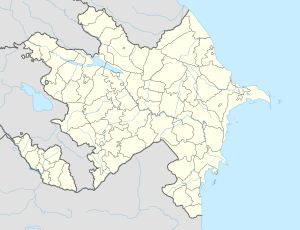Nursu (also, Nurs and Nur-su) is a village and municipality in the Shahbuz District of Nakhchivan, Azerbaijan. It is located 8 km in the north-east from the district center, on the foothill area. Its population is busy with gardening and animal husbandry. There is a secondary school, a library, a club and a medical center in the village. It has a population of 812.[1]
Nursu | |
|---|---|
Municipality | |
| Coordinates: 39°24′09″N 45°40′13″E / 39.40250°N 45.67028°E | |
| Country | |
| Autonomous republic | Nakhchivan |
| District | Shahbuz |
| Population (2005)[citation needed] | |
| • Total | 812 |
| Time zone | UTC+4 (AZT) |
Etymology
editThe name of the village is related to the name of the same named river in its area. And the name of the Nursu river means "the water which flowing water from the steep rock".[2]
Historical and archaeological monuments
editNursu Necropolis
editNursu Necropolis - the archaeological monument of the last medieval in the village of Nursu of the Shahbuz district. It is located on the top of the tall hill. It is the Muslim cemetery. According to the local people, there have been about 10 tombstones figures of a ram in the cemetery, the majority were destroyed, while others were transported. It is supposed that the monument belongs to the 15–16 centuries.[1]
St. Yerrordutyun Church
editSt. Yerrordutyun Church was an Armenian church located in the western part of the village.[3] It was founded in the 13th or 14th century and was destroyed at some point between 1997 and 2009.[3]
See also
editReferences
edit- ^ a b ANAS, Azerbaijan National Academy of Sciences (2005). Nakhchivan Encyclopedia. Vol. II. Baku: ANAS. p. 197. ISBN 5-8066-1468-9.
- ^ Encyclopedic Dictionary of Azerbaijan Toponyms. In two volumes. Volume I. p. 304. Baku: "East-West". 2007. ISBN 978-9952-34-155-3
- ^ a b Khatchadourian, Lori; Smith, Adam T.; Ghulyan, Husik; Lindsay, Ian (2022). Silent Erasure: A Satellite Investigation of the Destruction of Armenian Heritage in Nakhchivan, Azerbaijan. Cornell Institute of Archaeology and Material Studies: Ithaca, NY. pp. 398–401. Archived (PDF) from the original on 24 September 2022.
